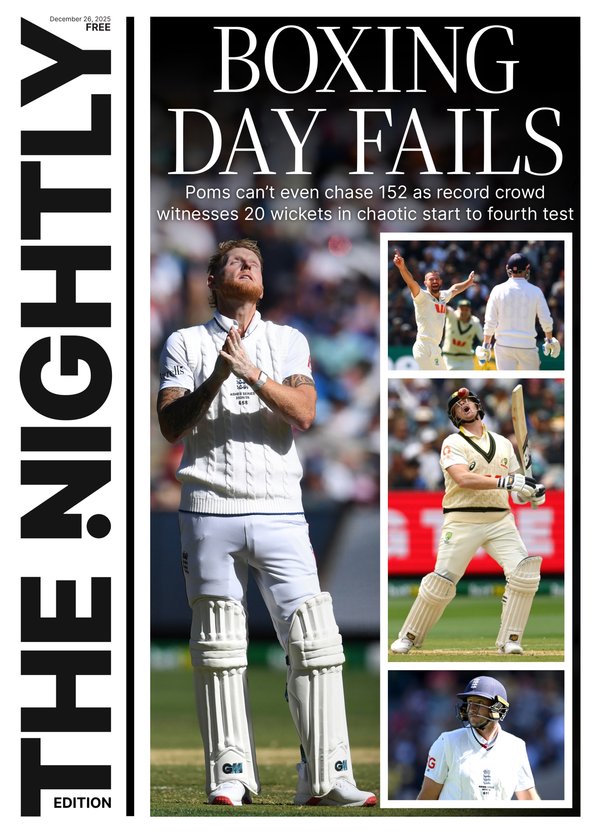Apple has created the thinnest smart phone ever. But will Australians upgrade for $1800?
Apple’s new iPhone is thinner, lighter and lasts longer than previous models. But the $1799 cost of the iPhone Air may be too high for many Australians to upgrade, an expert says.
The thinnest iPhone ever is 2.2 millimetres thinner and rounder than last year’s iPhone 16 -- a style said to be a retro chic and reminiscent of the first iPhones from 2007.
At only 5.6mm thick, it weighs less than a carton of cigarettes. But the starting price of $1,799 is a potentially off-putting factor among many consumers still gloomy about the economy.
Sign up to The Nightly's newsletters.
Get the first look at the digital newspaper, curated daily stories and breaking headlines delivered to your inbox.
By continuing you agree to our Terms and Privacy Policy.Apple and the big telcos Telstra and Optus will take online orders from Friday, a week before they arrive in stores.
Economist Nicki Hutley warned consumers may be reluctant to switch to a new model that offers few new features. While inflation has moderated, she said consumers still saw little point upgrading to a new iPhone with only a minor change in new features compared with previous upgrades that offered much more powerful cameras.
“I’m a bit of an old fart,” she told The Nightly. “I use my phone until it stops working but I think a lot of younger people have this expectation that you just upgrade to the next thing but I don’t think they feel the same way as they might have done five years ago.
“When you’ve got a lot more change between models. You went from a six-megapixel camera to a 12 megapixel camera whereas now it’s marginal differences so why spend all that money?”
iPhone 17
Apple also unveiled the iPhone 17 and 17 Pro Max at an event in the Californian city of Cupertino early Wednesday Australian time. Early reviewers raved about the phones’ bold new colours and the fact the three cameras are lined up across the back of the phone instead of in the top left corner.
The Verge website noted the iPhone 17s were very light. ‘The profile is as slim as it looks in photos, and it has more rounded edges reminiscent of previous iPhone designs,’ it said.
Tech Radar went further and described the iPhone 17 as a bigger evolution than many realised.
“I don’t think I fully comprehended just how radical a redesign and refashioning of Apple’s flagship handset, the iPhone 17 Pro (and 17 Pro Max), would be until I held one in my hand.”
Local non-buyers
With Australian pre-orders just two days away, customers at Apple’s George Street store in Sydney were reluctant to upgrade to the new Air model.
Sales rep Bobby Affridi, 38, is sticking with his four-year-old iPhone 13. “That’s a bit of a scandal though - $1400 and that’s also a payment plan on top of that as well,” he told The Nightly.
“Firstly, the cost, but secondly, my phone’s actually serving me very well so if it ain’t broke don’t try to fix it, right? I don’t know how slimmer they can actually get fitting all that technology in.”
A retired Sydney woman visiting the Apple store, was another tough prospect, considering her iPhone 16 is less than a year old.
“I believe in saving the planet and I’ve got a perfectly good iPhone 16 - why would I buy a 17? Waste of money,” she said. “Fourteen-hundred is a lot of money and I don’t need the thin phone. I’ve got a very good phone right now.”
Apple stores are traditionally the site of long queues when a new iPhone is released.
With the iPhone 17 competing with Samsung’s Galaxy S25 Edge, a younger woman was reluctant to switch to Apple.
“I like Samsung,” she said.
A retired Sydney IT technician described the iPhone 17 price as “outrageous”.
“I can get an Android for half the price; an Android is easier to use,” he said.
“That’s the main problem with Apple - you have to use Apple products; we’ve just been told about an Apple card and we have to do everything but give blood in order to use it.
“They’re ought to frigging have a rethink about the whole thing.”
Cautious consumers
Despite low unemployment, and booming share and property markets, consumers are more pessimistic than optimistic. The latest Westpac-Melbourne Institute consumer sentiment survey for September was at 95.4, which is below the 100 point level signifying sunshine instead of gloom.
Asked if Australians feel now is the time to buy a major household item, the score of 98.2 indicated more negative than positive responses.
The Reserve Bank’s three rate cuts since February are yet to encourage consumers to buy something they don’t need right now.
The 30-day interbank futures market doesn’t see the RBA cutting rates again until November 4, following the release of September quarter inflation data.

